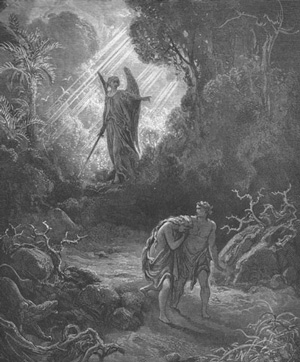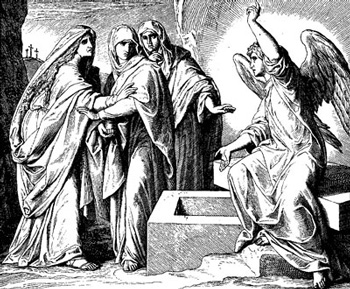One common accusation that is made against the Bible is that it does not give women
the same status as men. Indeed, superficial reading of certain passages
in the Mosaic Law and Paul’s writings initially seems to support such a conclusion.
However, a proper reading of Scripture reveals a high view of women which
is ultimately rooted in creation, and even the controversial passages, when seen
in their historical context, are in agreement with this high view.
Sketch by Paul Gustave Doréz www.wikipedia.com

From the very first chapter of Scripture, women are afforded a higher place than
in any other ancient writing; in
Genesis 1:27, women are said to be created in the image
of God just as men are, yet there is a distinction between the two from the beginning.
“Although male and female hold in common the same unique God-given status
as image-bearers, there is an inherent distinction within the human family by virtue
of their different sexual roles, and this implies that other distinctions are present.”
1 In the expanded account of
Day 6 in Genesis 2, the author gives a more detailed account of the
creation of woman. Up until this point, when God has evaluated His creation, He
declared it to be “good”. However, in the first and only negative statement,
He says that it is “not good” for man to be alone; he needs a “helper
corresponding to him” (2:18). God essentially states that man by himself is not
adequate; this highlights the high value and necessity of women in the biblical
view.
2 Adam’s joyful
exclamation (2:23) at their introduction affirms Eve’s ontological
equality with Adam, yet the fact that he names her indicates that she is subordinate
to him in some sense.
3 This
is important because it shows that there was a pre-Fall relational subordination,
so male headship, though doubtlessly twisted and abused by the Fall, was not itself
a product of the Fall.
Women and the Fall
Unfortunately, the first account of a woman’s actions in the Bible is the
one of the most infamous actions in all of Scripture: Eve eats the forbidden fruit
and convinces Adam to do the same, resulting in sin and death for themselves and
all their descendants. Non-canonical Jewish literature, like
The Apocalypse of Moses,
tends to blame Eve for the Fall, and to have a lower view of women for this reason.
However, nowhere in Scripture is Eve ultimately blamed for the Fall. Uniformly,
Adam is blamed for the introduction of death. In this passage, the sentence
of death is pronounced to Adam, not Eve. It is Adam whom Paul contrasts with Christ;
he argues that Christ’s action brought life for all those under him just as
Adam’s, not Eve’s, action brought death for all those under
him (
Romans 5:12 ff.
4,
1 Corinthians 15:21–22,
45).
Women in the Old Testament
Illustration by Julius Schnorr von Carolsfield

The Gospels record that women were the first witnesses to the Resurrection
From the time of the patriarchs on, there is evidence that women were not seen as
spiritually inferior to men. Rebekah enquires of the Lord about Jacob and Esau wrestling
in her womb (
Genesis 25:22–23), demonstrating that a woman was
free to approach God without a male intercessor. Some women, such as Miriam (
Exodus 15:20) and Huldah (
2 Kings 22:14,
2 Chron. 34:22) were recognized as prophetesses,
and seemed to command the same level of respect as their male counterparts. With
respect to female judges, Barak refuses to go to battle unless Deborah accompanies
him, showing that he believes that God is with her (Judges 4). Women were able to take the Nazirite vow, which
constituted taking on the highest level of sanctification possible for a non-Levite
Jew, under precisely the same requirements as male Nazirites (Numbers 6). This passage “explicitly emphasizes the
potential of women entering into this consecration service to Yahweh. Women could
not serve as priests in the Israelite cultus, but this manner of service was open
to them and could fulfill their desire for holiness and special service to the Lord.”
5
Most of the complaints about patriarchy in the Bible come from the Mosaic Law. However,
in many ways this was a significant advance for women in the ancient world compared
to other law codes. In cases of adultery,
both the male and the female
were to be executed (
Leviticus 20:10); in other ancient law codes, only the woman
was punished. Where there are differences in the law for men and women, it is beneficial
for the woman: for instance, a woman who made a rash vow was excused if her father
or husband (depending on her marital status) would not allow her to follow through
with it (Numbers 30); there was no such exception for men.
The Purity Laws
There are two instances where the Jewish purity laws are considered by some to be
especially misogynistic, those concerning uncleanness related to a woman’s
menstrual cycle (
Lev. 15:19–24), and those relating to childbirth (
Lev. 12). These will be examined separately.
The form of uncleanness incurred by menstruation seems to be less serious than other
uncleanness; someone who touches a menstruating woman is unclean until evening,
but does not have to wash, as with other forms of uncleanness. Hartley points out
that this law is not discriminatory against women because both men and women are
made unclean when they have discharges; women are unclean for a longer period simply
because their menstrual cycles last longer than a man’s seminal emission.
This could even be beneficial for the woman, as her husband is prohibited from sexual
intercourse with her during a time when it would be more uncomfortable for her.
6
A woman who gave birth to a daughter incurred both the more severe and the less
severe uncleanness for twice as long; the total period of uncleanness after the
birth of a son was forty days, compared to eighty days for a daughter. The reason
for the differing length of uncleanness is unknown; however, this is not a reflection
on the comparative worth of sons and daughters: greater periods of uncleanness was
not an indication of lesser social value. Indeed, the Holy Scriptures themselves
were regarded as books that “defiled the hands” precisely
because
they were holy, as shown in the rabbinical literature:
“The Sadducees say, we cry out against you, O you Pharisees, for you say,
‘the Holy Scriptures render the hands impure,’ [and] ‘the writings
of Hamiram do not render the hands impure.’ Rabban Yohanan b. Zakkai said,
Have we naught against the Pharisees save this! For lo, they say, ‘the bones
of an ass are pure, and the bones of Yohanan the high priest are impure.’
They say to him, As is our love for them, so is their impurity—that no man
make spoons of the bones of his father or mother. He said to them, Even so the Holy
Scriptures: As is our love for them, so is their impurity; the writings of Hamiram
which are held in no account do not render the hands impure.”7
It is notable that the sacrifices for a male and female child were the same; this
is one way of affirming the equal worth of sons and daughters in God’s sight.
8 In any case, ritual uncleanness
was never seen to be sinful even in the rabbinic literature; it was unavoidable
for the average Jew. And since ritual cleanness only affected one’s ability
to participate in Temple worship and the feasts (with the exception of Passover),
it is doubtful how much ritual uncleanness would affect one’s day-to-day life.
Other laws were for women’s benefit as well. A woman who was raped was provided
for by forcing the man who raped her to support her for the rest of her life (
Deuteronomy 22:28–9). Even the women of conquered people
had to be treated with dignity. Jewish daughters could even inherit property when
there were no sons (Numbers 27, 36).
Many women are portrayed positively in Scripture. The Hebrew midwives who spared
the Hebrew male children were blessed by God with their own families (
Exodus 1:15–21). Rahab is portrayed positively for
hiding the Hebrew spies (Numbers 6,
Hebrews 11:31,
James 2:25), and ultimately became absorbed into
the Jewish people and was an ancestor of Jesus (
Matthew 1:5). Ruth is a model of loyalty and faithfulness
who became the great-grandmother of King David (
Ruth 4:17), and thus another ancestor of Jesus (
Matthew 1:5). Esther’s obedience to her cousin
Mordecai led to the deliverance of the Diaspora Jews in Persia. Wisdom is personified
as a woman in Proverbs, and it would be hard to find more glowing praise of a woman
in ancient literature than Proverbs 31.
Women are never caricatured as evil in the Bible, in contrast to some of the rabbinic
literature. Some individual women such as Jezebel and Delilah are portrayed as evil,
but this is never turned into a generalization of women’s inherent nature.
There are also many evil men portrayed in Scripture as well as women, so this cannot
be used as proof of an anti-female agenda in Scripture.
It is ironic in light of the charges of patriarchy in Judaism to consider that it
was easier for a female Gentile to convert to Judaism; the circumcision requirement
for men meant that women were more likely to convert fully, while men often opted
to become “God-fearers”, those who worshipped the true God without fully
converting to Judaism.
Women in the New Testament
Judaism is perhaps surpassed only by Christianity in its high view of women. Many
New Testament women are portrayed positively; Mary the mother of Jesus is portrayed
willing to believe God and to be the mother of the Messiah, even though she could
be divorced, publicly humiliated, and even stoned for becoming pregnant before marriage
(Matthew 1; Luke 1). Women made up a large part of Jesus’
following, and Jesus was probably financed by wealthy women such as Mary Magdalene;
the Bible refers to “many women” being among His followers and caring
for His needs (
Matthew 27:55), though only men were chosen to be apostles.
It is noteworthy that women were the first witnesses of the Resurrection, because
by the time of Jesus the Jewish culture had so strayed from a Scriptural mindset
that women were generally considered to be less reliable witnesses than men; their
testimony was not considered to be valid in a court of law.
Some people admit that Jesus Himself had a high view of women, but allege that his
followers corrupted His message and relegated women to “second-class”
in the Church. But this does not take into account that the above positive portrayals
of women in the context of Jesus’ ministry were recorded and preserved by
those in the very Church they accuse of being misogynistic. And it is clear that
women held important positions in the early church; Priscilla (also called Prisca)
was active in ministry as a partner to her husband, Aquila, and is even listed first
in most mentions of the couple, indicating that she may have been the more prominent
of the two in certain contexts (Acts 18,
Romans 16:3,
1 Cor. 16:19,
2 Tim. 4:19). Phoebe was probably the letter
carrier for Romans (16:1). Women were allowed to pray and prophesy in meetings
of the early church; Paul lays down rules for how women are to pray and prophesy,
namely that they do so with their head covered, but does not prohibit it (
1 Cor. 11:1–16).
Paul is often called a “misogynist” because of his commands that a woman
not teach or have authority over men (
1 Timothy 2:12). But this is simply an instance of Paul
affirming that in the created order, men and women are different, and have different
roles in worship. The role of men is to teach, and the role of women is to learn
in submission. But, again, Paul is not saying that the teacher is ontologically
superior to the women learning from him. Paul only prohibits women from teaching
men in the church; they are encouraged to teach other women and their children,
including their sons (
2 Timothy 1:5,
3:14–15).
9
The word
αὐθεντεῖν (
authentein) in
1 Timothy 2:12 is a New Testament
hapax legomenon
which only occurs a few times in secular Greek literature. Some claim that this
has a negative connotation, unlike the neutral term
ἐξουσιἁζω
(
exousiazō) which can be positive or negative based on the context.
All the same, Moo argues that
authentein means simply “exercise authority”,
in the neutral sense of “have dominion over”, not the negative sense
of “lord it over”.
10
This was based on the meanings of the word in the times closest to Paul’s
writings,
11,
12 and it was overwhelmingly the case in Patristic
writings.
13 Moo also argues
that Paul used
exousiazō only three times so it was hardly in his
usual vocabulary.
Note also, Paul doesn’t ground his teaching on cultural factors but on a straightforward
understanding of the Genesis creation account. I.e. Paul accepts Adam and Eve as
real people, and even affirms the facts that Adam was created first (Genesis 2) and that Eve was deceived while Adam was not
(but sinned anyway, Genesis 3).
1 Corinthians 14:34–35, “
The
women are to keep silent in the churches; for they are not permitted to speak, but
are to subject themselves, just as the Law also says. If they desire to learn anything,
let them ask their own husbands at home; for it is improper for a woman to speak
in church”, must be seen in the light of its context. Three
chapters earlier Paul did not condemn the practice of women prophesying in church,
meaning that they
were allowed to speak in church in some contexts. And
in 1 Corinthians 14 he is talking about
order in the
church. Carson argues that Paul is prohibiting women from participating in the oral
evaluation of prophecies; though they were allowed to prophesy themselves, they
were to remain silent when prophecies were weighed.
14
Do differing roles inherently devalue women?
Few would disagree with the assertion that the Bible does prescribe different roles
for men and women (the debate usually centers on whether those differences are based
in cultural or universal commands). Some would argue that any difference in roles
is demeaning to women, and that the Bible devalues women because women are not allowed
to do everything that men are allowed to do. But one could argue that by affirming
the
goodness of the inherent differences between the sexes, the biblical
worldview is more
pro-woman, whereas the feminist view actually
devalues
women by devaluing or ignoring innate differences between women and men. To the
feminists, women and men are interchangeable (except that men are bad!); to the
Christian, they are both indispensible.
Christians have always affirmed that it is possible for individuals to submit to
others without implying an ontological inferiority. Jesus, God the Son, submitted
to the Father (
Luke 22:42); and no orthodox Christian would claim that
Jesus was less God than the Father because of it (
Phil. 2:6,
John 10:30). Indeed, Christ submitted to His mother
and stepfather (
Luke 2:51), although He was infinitely
superior.
In the same way, the command for wives to submit to their husbands (
Ephesians 5:22 ff.) does not dehumanize women, especially
as the husbands are then commanded to love their wives as sacrificially as Christ
loved the Church.
The relational maleness of God
Illustration from <www.wikipedia.com>

Some feminist scholars claim that even the idea of a male God is demeaning to women.
They argue that women cannot be fully in God’s image if God is in any meaningful
sense male and not female. Some go so far as to advocate throwing out male imagery
and names for God altogether, instead adopting female imagery and names. There are
bizarre examples of Bible translations like Oxford’s
New Inclusive Translation
which calls Jesus “The Human One” instead of His self-designation “Son
of Man” and calls the Father “Father-Mother”.
15
Christians believe that it is only possible to know the information about God that
He reveals to us Himself through Scripture. Of course, God is Spirit (
John 4:24), so is biologically neither male nor female,
and He does not have a sexual nature. Rita Gross objects: “If we do not mean
that God is male when we use masculine pronouns and imagery, then why should there
be any objections to using female imagery and pronouns as well.”
16 The simple answer is that God is described in
male terms because that best describes how God relates to His creation; God has
revealed Himself to humanity in male terms. God became incarnate as a man, not a
woman.
Identifying God in female terms leads to a fundamental change in how God is viewed:
“He is no longer Lord over the world, but a mother birthing it. He is no longer
king over his realm, but the world is actually part of his (her?) body. It seems
that the evangelicals who wish to simply add mother to the list of names for God
in the Scriptures, have no way of preventing this kind of revision of the way in
which God relates to the world. Once the authority of scripture is given up with
regard to the name (mother), there is no authority to which they may appeal to argue
against the natural revisions of the God-world relationship associated with feminine
language.”
17
The Bible is clear about the “otherness” of God; the creation narrative
in Genesis clearly illustrates that God existed before the creation and is completely
separate from it. Those who identify God in female terms have no way to prevent
this fundamental change in the view of God where the creation becomes part of God. This is known as
panentheism and thus in some way humanity becomes divine in this view as well. (Note,
panentheism = God is in everything, as opposed to
pantheism God is everything and everything is God.
Does the Bible use female imagery for God?
Some feminist theologians and writers claim that Scripture contains feminine or
maternal imagery as well as masculine imagery. Some of this is simply linguistic
gender; both Hebrew and Greek, like French and Spanish, use gender for nouns. The
words for “spirit”(
רוּהַ
rûach) and wisdom (
הָכְמָה
chokmāh) take the feminine gender in Hebrew. But this does not make
them intrinsically feminine any more than truth or sin, both of which take the feminine
article in Greek (
ἀλήθεια
(
alētheia) and
ἀµαρτία
(
hamartia)).
18
Furthermore, when
ruach is used for the Spirit of God, it is always combined
with the masculine
Elohim and takes on its masculine characteristics. E.g.
in
1 Kings 22:24: ‘Which way did the Spirit of the Lord
go …?’, the word
rûach takes the masculine verb
עכַר ‘ābar:
“went”.
19
Another type of instance that is claimed as evidence of God being described in feminine
terms is in similes and metaphors. But similes and metaphors always are comparing
attributes of one thing with attributes of another they never mean that one thing
is literally the other thing. When God is called a “rock” in
Deuteronomy 32:4, it is nonsensical to ask, “Granite
or limestone?” because it is correctly understood to be non-literal. The same
principle applies a few verses later when God is compared to an eagle who protects
its young (32:11). It is ridiculous to infer from the imagery that
God is female; it would be just as justified in the context to assume that this
verse teaches that God has feathers and wings! This is not even simply a question
of bad hermeneutics (which it is), but of poor basic reading comprehension, whether
intentional or not, on the part of these scholars.
Male imagery referring to God
The male imagery used to depict God is fundamentally different from the female similes
found in Scripture. God may be
like a mother in certain aspects, but He
is Father; Jesus prayed to Him as Father and taught His disciples to do
the same (
Matt 6:9). The Second Person of the Trinity, Jesus Christ,
became incarnate as a man, not a woman, and Jesus referred to the Holy Spirit with
the pronoun “He” (
John 14:16–17). These are not similes or metaphors,
but teaching regarding the very nature of God and how He relates to His creation,
and how the members of the Godhead relate to each other.
Was male imagery and incarnation a concession to a patriarchal culture?
Some scholars admit that the Bible depicts God in male terms, but argue that it
was simply because the patriarchal culture would not accept a female God. Some go
so far as to argue that the only reason that Jesus couldn’t have been a female
is because the culture was not ready for a female Messiah. However, much of this
so-called patriarchy is contained in the Mosaic Law, which God gave to Israel! God
could have revealed Himself in female terms if it were an accurate portrayal of
His nature, and He could have prepared the culture for a female Messiah. On a similar
note, it is also claimed that the only reason Jesus had to be male was that a female
would not be accepted as a teacher in first century Palestine. It is not even clear
if the culture was as patriarchal as is claimed; many ancient cultures worshipped
goddesses (see, e.g.
Acts 19:27–28) and Paul even had to straighten out
the Corinthians about women’s proper place in church services (
1 Corinthians 14:33–38).
This objection is absurd even on the face of it—the Prophets and Jesus themselves
frequently
challenged the culture of their day, where it didn’t match
God’s standards. Indeed, humanly speaking, Jesus’ enemies wouldn’t
have bothered to crucify Him if he had not been a staunch critic of much of the
culture.
Some go so far as to claim that Jesus was either genetically or psychologically
female; since Jesus did not have a human father, the argument goes, all His genetic
material came from Mary. They argue that since Mary did not have a Y chromosome,
Jesus must have been genetically female, though male in appearance. But it should
be obvious that the God who created the universe surely would have no problem in
creating a Y chromosome.
Is it anti-female to refer to God with male pronouns?
The issue is: who defines how we relate to God: us or God?
A truly biblical understanding of God is far from anti-female, because both male
and female are created in the image of God (
Genesis 1:26–28). Some imagery used in the Bible may
even be easier for females to understand and relate to; e.g. the Church as the bride
of Christ (
Ephesians 5:22–33,
Revelation 21:9,
17).
The issue is:
who defines how we relate to God: us or God? If we refer
to humans by the names, and even with the pronouns, that they wish to be known by,
it seems to be common courtesy to do the same for God. If God reveals Himself as
Father, King, Lord, etc, it seems obscene to insist on calling Him Mother, Goddess,
etc. As Michael Bott argued, “respecting the requested manner of address is
good manners at least. So we call God our ‘Father’ because to do otherwise
is simply rude.”
20
Furthermore, in the Bible naming someone or something symbolized authority over
that person.
Does secularism have anything better to offer?
Early Christianity and ancient Judaism before it were both light-years ahead of
their cultures regarding the treatment of women. On the other hand; secularists
have been shown to be anti-female. Many evolutionists, including Darwin, have argued
that women are inferior to men,
21
since the weaker men are eliminated by war and other things, but weaker women are
not eliminated by such forces—instead, men protect weak women. Thus the male
population is worked on by natural selection where only the strongest survive, but
the women who men find attractive, not necessarily the strongest or most “fit”,
reproduce. One evolutionist even argued that females were closer to animals than
to males. Indeed, sexual equality would be totally unexpected under consistent evolutionary
theory, since males and females throughout the biosphere experienced different selective
pressures. We see the fruits of this with the widespread abortion of baby girls.
22
Conclusion
Far from being repressive for women, the biblical worldview is better for women
than its secular counterpart, because it recognizes and celebrates the innate differences
between men and women while affirming the ontological equality of men and women
as created in God’s image. This positive view of women is seen throughout
Scripture. That Christians with a biblical view of God insist on calling Him by
the male names He has given Himself in no way reflects negatively on the biblical
view of women, because both men and women are created in the image of God. Because
of this, Christians are commanded to treat both men and women with proper dignity
and respect. Replacing biblical language for God with unbiblical female names and
terminology does not elevate women, but is an attempt to redefine God Himself. The
same hermeneutic that allows exegetes to replace “Father, Son and Holy Spirit”
with “Mother, Daughter, and Life-bearing Womb” would also free humans
to reinterpret any part of Scripture to fit with the spirit of the age—
including
the many parts of the Bible which are explicitly pro-female! If we are
free to redefine even one word of Scripture, not one word of it is unchangeable.
Related Articles
References
- Matthews, K., Genesis 1–11:26, The New American
Commentary, Broadman and Holman, Nashville, TN, p. 173, 1996.
Return to text.
- Wenham, G., Genesis 1–15, Word Biblical Commentary,
Word Books, Waco, TX, p. 68, 1987. Return to text.
- Wenham, ref. 2, p. 71. Return to text.
- Cosner, L.,
Romans 5:12–21: Paul’s view of a literal Adam, J. Creation
22(2):105–107, 2008. Return to text.
- Cole, D., Numbers, The New American Commentary, Broadman
and Holman, Nashville, TN, p. 121, 2000. Return to text.
- Hartley, J., Leviticus, Word Biblical Commentary,
Word Books, Dallas, TX, 1992. Return to text.
- m. Yad. 4:6, cited in Milgrom, J., Leviticus 1–16,
The Anchor Bible, Doubleday, NY, 1991. Return to text.
- Hartley, ref. 6, p. 169. Return to text.
- Knight, G.W. III, The Pastoral Epistles: A Commentary
on the Greek Text, Eerdmans, Grand Rapids, MI, pp. 140–141, 1992.
Return to text.
- Moo, D., What does it mean to teach or have authority over
men? Chapter 9; in: Piper, J. and Grudem, W. (Eds.), Recovering Biblical Manhood
and Womanhood, Crossway, Wheaton, IL, pp. 186–187, 1991.
Return to text.
- Knight, G.W. III, Authenteō in reference to
women in 1 Timothy 2:12, New Testament Studies 30:143–157,
1984. Return to text.
- Wilshire, L.E., The TLG computer and further reference to
Authenteō in 2 Timothy 2:12, New Testament Studies 34:120–134,
1988. Knight deals only with the verb, while Wilshire deals with all words with
the authen– root. Both conclude that authenteō means
“exercise authority/power/rights”. Return to text.
- Lampe, G.W., Patristic Greek Lexicon, Oxford University
Press, UK, p. 262, 1968. Return to text.
- Carson, D.A., “Silent in the churches”: on the
role of women in 1 Corinthians 14:33b–36, Chapter 10; in: Piper and Grudem,
ref. 10, pp. 142–144. Return to text.
- Neff, D., Lost in translation: can the New Inclusive
Bible’s Human One, child of father-mother God, save us? Christianity
Today 39(2):19, February 1995. Return to text.
- Gross, R., Female god language in a Jewish context; in: Christ,
C. and Plaskow, J. (Eds.), Womanspirit Rising: A Feminist Reader in Religion,
HarperCollins, NY, p. 173, 1979; cited in Bott, M., Is God She? Apologia
5(2):5–20,1996; p. 9. Return to text.
- Stinson, R., Our mother who art in heaven: a brief
overview and critique of evangelical feminists and the use of feminine God-language,
Journal of Biblical Manhood and Womanhood 8:30, 2003.
Return to text.
- Jeffery, D., Inclusive language and worship: the
central role of language in defining the people of God, The Reformed Journal
13–22, August 1987. Return to text.
- Taylor, C.V.,
Linguistics, Genesis and evolution, Part 5: The Creator, Creation
7(4):21–23, 1985. Return to text.
- Bott, M., Is God she? Apologia 5(2):5–20,
1996; p. 11–12. Return to text.
- Bergman, J.,
The history of the teaching of human female inferiority in Darwinism, J. Creation
14(1):117–126, 2000. Return to text.
- Cosner, L., Abortion: an
indispensable right or violence against women? 7 February 2007,
creation.com/abortsex.
Return to text.













